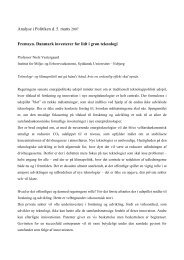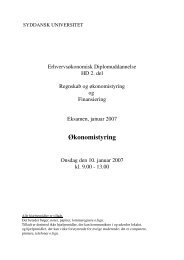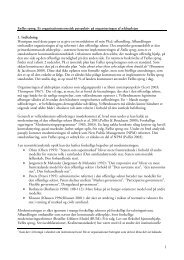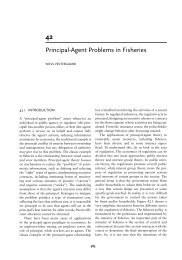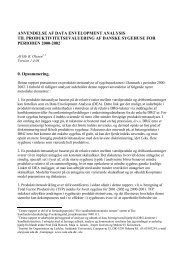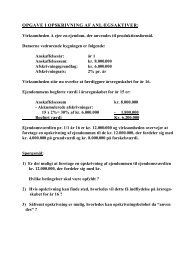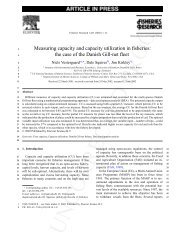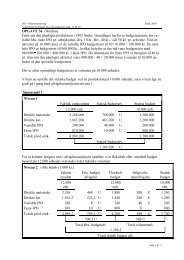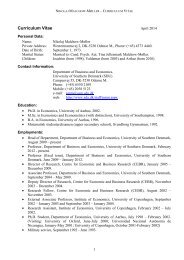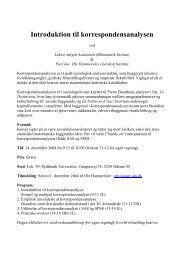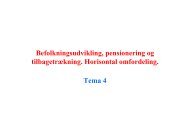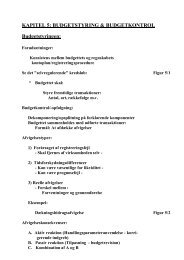Development of Parties and Party Systems in ... - lah@sam.sdu.dk
Development of Parties and Party Systems in ... - lah@sam.sdu.dk
Development of Parties and Party Systems in ... - lah@sam.sdu.dk
- No tags were found...
Create successful ePaper yourself
Turn your PDF publications into a flip-book with our unique Google optimized e-Paper software.
In the late 1990’s it was almost fashionable to use the party label ”Christian”. However, <strong>in</strong> the midwaryears Christian parties had not played an important role <strong>in</strong> Polish politics <strong>and</strong> undercommunism such parties were forced to work underground. After 1989 Christian parties werereborn <strong>and</strong> re-activated. Like the notion ”social democratic”, the name ”Christian” signalled pro-European <strong>and</strong> pro-capitalistic attitudes. As we have seen, Christian parties covered a broad politicalspectre, represent<strong>in</strong>g extremist fundamentalist catholic party types <strong>and</strong> <strong>in</strong>stitutions like RadioMaryja <strong>and</strong> KPB-OP, at the 2001 election the League <strong>of</strong> Polish Families (LPR) as well as centreorientedpro-market political formations like the Freedom Union (UW) <strong>and</strong> the Centre Alliance(PC).2.12. Peasant <strong>Parties</strong>: PSL <strong>and</strong> “Selfdefence” (Samoobrona)S<strong>in</strong>ce 1989 class based parties with a broad appeal to rural areas have existed <strong>in</strong> almost all Central<strong>and</strong> East European countries. In the Central European countries the most important have been theIndependent Smallholders <strong>Party</strong> (FKGP) <strong>in</strong> Hungary, the Polish peasants party PSL <strong>and</strong> the populistSammoobrona (“Self-Defence”), <strong>in</strong> the Czech Republic the centrist Christian, social-liberal <strong>and</strong>moderate rural party KDU-CSL. Peasant parties have entered different party coalitions <strong>in</strong> Slovakia,never ga<strong>in</strong><strong>in</strong>g seats <strong>in</strong> parliament when go<strong>in</strong>g alone. In the follow<strong>in</strong>g sections we shall focus on thePolish PSL <strong>and</strong> Samoobrona (“Selfdefence”) <strong>and</strong> <strong>in</strong> a f<strong>in</strong>al section the Czech Christian DemocraticKDU-CSL.The Polish Peasants <strong>Party</strong> (PSL) emerged <strong>in</strong> November 1989 as a successor party <strong>of</strong> the UnitedPeoples <strong>Party</strong> (ZSL) that had been represented <strong>in</strong> parliament before 1989 <strong>and</strong> cooperated with thethen rul<strong>in</strong>g communist party (PZPR). Support for Polish agriculture <strong>and</strong> the rural areas has beencrucial political question for the party. The basis for a rural class party is great <strong>in</strong> Pol<strong>and</strong> as aboutone third <strong>of</strong> the Polish population is closelyl<strong>in</strong>ked with agriculture. The parties had to act as a ruralcatch-all party. However, soon different factions emerged. One faction supported Christian values,rem<strong>in</strong>d<strong>in</strong>g us about <strong>in</strong> Christian-National parties like PL <strong>and</strong> ZChN, another faction was moresecular <strong>and</strong> pragmatic bas<strong>in</strong>g itself on the traditions from before 1989, first <strong>of</strong> all the then procommunistZSL.Polish agriculture can be divided <strong>in</strong> different social groups. The first group <strong>in</strong>cludes the bigger <strong>and</strong>more efficient agricultural units that produce enough to sell their products to the market <strong>and</strong> br<strong>in</strong>gthe farmer a yearly <strong>in</strong>come comparable to other social groups. Another group only produce for ownconsume, <strong>and</strong> a third group consist <strong>of</strong> small <strong>in</strong>efficient units, on which the owners will be forced t<strong>of</strong><strong>in</strong>d new jobs because <strong>of</strong> merger <strong>of</strong> small units. If we take <strong>in</strong> consideration that about 100.000 jobs<strong>in</strong> m<strong>in</strong><strong>in</strong>g had to be closed down <strong>and</strong> new great <strong>in</strong>flux <strong>of</strong> young people to the labour market about2.5 to 3 mio. new jobs have to be created outside agriculture just to ma<strong>in</strong>ta<strong>in</strong> the same level <strong>of</strong>unemployment. To day about 60 percent <strong>of</strong> Pol<strong>and</strong>’s poor live <strong>in</strong> the rural areas.Thus to cover all farmers <strong>in</strong> Pol<strong>and</strong> by one party was no easy task. As a party the Peasants <strong>Party</strong>(PSL) reflected the structure <strong>of</strong> Polish agriculture. Factions represent<strong>in</strong>g the bigger units have beenconfronted those represent<strong>in</strong>g the small units. Nonetheless <strong>in</strong> some years the party succeeded tokeep a united facade, at least publicly. The disagreements, however, were grow<strong>in</strong>g before the 1997election. The m<strong>in</strong>ister <strong>of</strong> agriculture <strong>in</strong> the SLD-PSL government Roman Jagielski behaved like aspokesman <strong>of</strong> the greater agricultural units <strong>and</strong> expressed more pro-EU attitudes. His opponent wasthe then party leader Waldemar Pawlak who expressed the more traditionalist agrarian attitudes <strong>and</strong>defended the smaller agricultural units. Accord<strong>in</strong>g to Jagielski most important was to create new73



